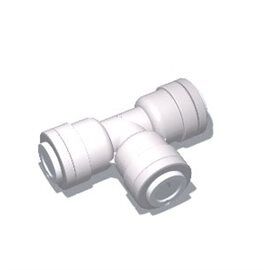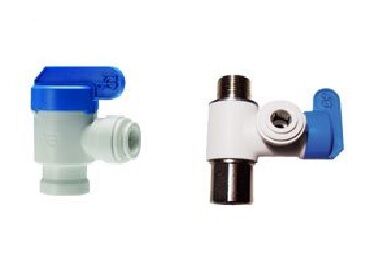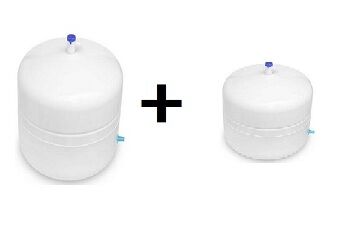You hate to have to go out and buy bottled water when you have a reverse osmosis system at home but you want to have more reverse osmosis water. Can you add a second storage tank to your reverse osmosis system so there will be more water available?
You can add a second water storage tank to your reverse osmosis drinking water system by adding a “T” connector and a second tube to a second storage tank to tie two tanks together for additional reverse osmosis water storage.
Your reverse osmosis makes great-tasting drinking water for your family, but there is never enough reverse osmosis water to go around when everyone is home and drinking water.
Adding a second reverse osmosis water storage tank is actually quite easy, but there are some things that you should consider before adding a second storage tank.
How to add a second storage tank to a reverse osmosis system.
To add a second water storage tank to a reverse osmosis system you will need a tubing “T” connection to join the two tanks together and an additional piece of tubing to go to the second storage tank.

In most cases, if there is a little extra tubing already going to your reverse osmosis storage tank, you can simply cut off a piece that you can use to connect the second storage tank. If not, you should be able to pick-up a few feet of the correct sized tubing at your local hardware store.
You will want to have a towel ready as there will be some water to clean up when adding a second tank to your reverse osmosis system so I suggest getting one before you begin along with a work light if necessary and a sharp knife or tubing cutter to cut the tubing needed to install the second tank.
Shut-off the water feeding your reverse osmosis system and the shut-off on the existing storage tank, then turn on the reverse osmosis faucet until you see the water stop flowing.

Once the water from the reverse osmosis system stops, remove the tubing from the existing storage tank by pressing the tubing in about 1/4 inch, then while holding the grab ring in, pull the tubing out.
Make sure the ends of the tubing are free of burrs and sharp edges then insert the tubing coming from the reverse osmosis system into the middle opening of the “T” connection and then insert a tube into each end of the “T” going to the two storage tanks.


Simply push the tubing into the quick connect “T” fitting as far as it will go and then give it a little pull to make sure that it is secure. If you need to remove the tubing from the quick disconnect fitting, press the tubing in about 1/8 inch and then hold the grab ring into the fitting while pulling the tubing out and it should come out easily.
Once you have the tubing from the reverse osmosis secure in the center opening of the “T” connection and the two tanks connected to the two ends of the “T” connector, you can turn the water feed to your reverse osmosis system back on, turn on the valve for both storage tanks, and shut off the reverse osmosis faucet so the tanks can both fill with filtered water.
After about four hours, both tanks should have enough water in them for you to start using them, but I recommend that you let the system sit overnight to completely fill both tanks and then turn on the reverse osmosis faucet and let both tanks empty out completely.
By emptying both tanks, you will ensure that freshwater fills both tanks, and no older water will mix with the new water being made by your reverse osmosis system.
How can I check my reverse osmosis storage tank to see if I should add a second tank?
If you’re thinking about adding a second water storage tank to your reverse osmosis system because you’re not getting as much water from your current tank as you used to, you should first check out these articles.
“Why is my reverse osmosis system slow?”
“How to repressurize a reverse osmosis storage tank?”
Your current tank may work just fine, it just needs to be re-pressurized to its optimum operating pressure so it will provide you with all of the water that it can. You also may have a clogged filter or other easy to fix problem with your reverse osmosis system that will make your existing storage tank work much better.
Do you really need a second reverse osmosis storage tank?
Many people just want a second storage tank for their reverse osmosis system so they will have lots of water available and never run out of reverse osmosis water.
The problem is, if you are only using 1 gallon of reverse osmosis water per day and have two storage tanks that hold a total of 5 gallons of reverse osmosis water, most of the water that you have ready to use will become stagnant and bacteria could potentially start to grow inside of the storage tanks.
Now, I always highly recommend sanitizing your reverse osmosis system and tank whenever you change your reverse osmosis filters, but when you have 2 storage tanks and are using much less water than they can store, bacteria can start to grow inside of the tanks way before it comes time to change your reverse osmosis filters.
If you have more people using reverse osmosis water on a regular basis, then you may want to have more filtered water ready to go, but I don’t recommend adding a second reverse osmosis storage tank unless you really have a need for additional filtered drinking water.
Check out these articles to make sure that your storage tank is working correctly.
“Why is my reverse osmosis system slow?”
“How to repressurize a reverse osmosis storage tank?”
Do the storage tanks have to be the same size?

Although a second reverse osmosis storage tank does not have to be the exact same size as your current storage tank, I do recommend that the second tank be relatively close in size to the original tank so that they will both work together rather than one tank providing most of the water most of the time and the second tank only providing water when drinking water usage is high.
Even though two tanks of different sizes may provide water equally when they are first connected, the different sized water bladders inside of the tanks may lose air pressure at different rates, and at some point, the tank with the stronger air pressure may end up providing most of your water while the water in the second tank becomes stagnant.
Do I need to get a second reverse osmosis storage tank that is the same brand?
Most brand standard type reverse osmosis storage tanks work exactly the same and will deliver water in the same way.
As long as your current reverse osmosis system uses a standard air charged storage tank, any brand air charged storage tank will work just fine, you just may have to use an adapter if the tubing size is different than what is on your existing storage tank.
Can I put the second storage tank in a different location?
Although I recommend keeping a second storage tank in the same location as your existing tank, you could place a second storage tank in a different location providing that you will be using the water from the second tank.
What I mean by this is that if you only use a few gallons of reverse osmosis water per day, you will probably be getting the water from the closer tank until it is empty, and then draw water from the second tank simply because it is farther away than the first tank.
If you have a high demand for reverse osmosis water and will be using as much water as both tanks can provide per day, the water should not become stagnant, and there will be much less chance of bacteria growth.
Can I put a second storage tank by my refrigerator for better water flow?
Adding a second reverse osmosis storage tank close to your refrigerator is often a very good idea! Your refrigerator needs a strong and steady flow of water for its dispenser and to make ice.
Many people who have poor water pressure going to their refrigerator ice maker will end up with small ice cubes or no ice at all. You don’t even need a very large second storage tank for this purpose, a small secondary water storage tank will work just fine to provide water to your refrigerator for the dispenser and to make full-sized ice cubes.
Is one larger storage tank better than adding a second storage tank?
I almost always recommend replacing your existing reverse osmosis storage tank with a larger sized tank rather than adding a second storage tank.
Most people don’t really need a lot more water than they get from their existing storage tank because their reverse osmosis system begins re-filling the storage tank after just a few ounces have been drawn from it.
A common sized 4-gallon reverse osmosis storage tank will hold about 2.5 to 3 gallons of water in it, but that does not mean that you will only have 2.5 to 3 gallons of water available to you each day.
Because your reverse osmosis system is regularly re-filling your water storage tank, you could get 24 gallons of reverse osmosis water per day if it is being used regularly during the course of the day and being re-filled.
Adding a second storage tank is really only beneficial if you need to have a high volume of water over a short period of time.
If everyone in your family fills up their water bottles first thing in the morning and your storage tank never seems to have enough available, adding a second storage tank or upgrading to a larger storage tank would be a great choice, but if you are not running out of filtered water now, sticking to your current storage tank will continue to work just fine.



I have a question about this setup. I tried setting up 2 tanks next to each other using the T connector exaclty as above but when I turn the water on the water shoots out of the tank valve and both ends of the Tconnector. Do you know how I can solve this problem? I tried both tanks separately and the work but not when I connect with the T. Any help would be great thanks.
Hello Susan and thank you for your question.
It sounds like you haven’t pressed the tubing into the connector far enough. When you insert the tubing, you will feel it stop when it hits the Oring seal inside of the connector.
Put a small pen or pencil mark on the tubing right at the opening of the connector to show how far the tubing has gone into the connector. Remove the tubing and make sure that the ends of the tubing have no sharp edges and then re-insert the tubing and attempt to push the tubing in farther than it was before.
You should feel some resistance and then the tubing will move about another 1/4 inch into the connector as it goes through the Oring. Give the tubing a slight pull to make sure that it is snuggly inserted and it should be inserted correctly.
I hope this was helpful.
Paul
Does adding a second tank require increased water pressure in the home to properly fill both tanks? I have confirmed that both tanks have ~8 PSI of pressure, but neither of the tanks is filling properly, causing very slow water flow. Also, to what degree will the age of the membrane affect the fill efficiency?
Hello Lee and thank you for the question.
Adding a second storage tank may cause the tanks to not fill as much as a single tank because there are now 2 pressurized tanks putting back pressure on the incoming water.
Normally this would only happen if the incoming water pressure is quite low because the pressure in the tank will increase as it is filled with water and could exceed the incoming water pressure. Normally the pressure in a FULL reverse osmosis tank could be as much as 30 to 40 PSI and if your incoming water pressure is less than the incoming water pressure, the tanks will not completely fill.
I suggest that you completely empty both tanks, disconnect them from each other and pressurize each of them (separately) to about 7 PSI to allow more water into the tank. If you check the air pressure while they are connected to each other, the pressure in one tank could affect the pressure reading in the other tank. At 7 PSI, the tanks will hold more water and still be able to dispense all of the water from their bladders.
For the most part, an older membrane will fill a storage tank faster than a newer membrane but a clogged membrane will restrict water flow to the tank and could cause the tank to not fill completely.
I hope this was helpful.
Paul
We are building a house and our sink is on the island. How would you go about getting RO to the refrigerator from the island RO system. Do we buy a second tank for the cabinet closes to the fridge? Do we run tubing under the flooring since it hasnt been laid yet? What would you recommend as the best choice.
Hello Ben and thank you for the question.
A second storage tank as close to the refrigerator would be advisable as it would provide pressurized water close to the refrigerator. You can either split the water right from the reverse osmosis or after the first storage tank but I would recommend splitting it right after the reverse osmosis and going to each tank separately.
I normally do run a line under the flooring as long as it will be accessible in the future. I don’t like to bury any tubing within the floor that would not be easily accessible later on. And if you are drilling holes in the floor joists, make them about two times larger than the tubing to prevent restriction and make it easier to replace in the future if need be.
I also recommend using 3/8″ tubing if possible to allow for more water flow to the second tank.
I hope this was helpful.
Paul
I recently had an RO system installed for drinking and cooking. I added a mini hot water heater after the RO. There doesn’t seem to be enough pressure to activate the heater. Would a separate tank work before or after the heater?
Hello Val and thank you for the question.
A storage tank after the heater could damage the bladder in the tank, would not provide better pressure and the water would not be kept warm.
A storage tank right before the water heater would provide better pressure to the heater but I would recommend that you contact the manufacturer of the heater because I have found that some under-sink water heaters do not work well if the water pressure is too high.
I hope this was helpful.
Paul
Hi,
We want to add a 800GPD RO System (3000 litre per day system) to our borehole system. So first the borehole water is going through a filter system that takes out all the sediment and it falls into a slimline tank. After that we want to add the RO system who will use the water from the slimline tank, filter it and pump it to the large holding tank to give us enough water storage. We are using about 1000 liter per day. From there a centrifugal pump takes it to the house to use when needed. My question: Will we be able to use the RO system to pump into the large tank? At the moment we are looking at the cheapest option as we just drilled the borehole and it cost us a large sum of money to do so. I would really appreciate your feedback. Thank you in advance
Hello Engela and thank you for the question.
Although not all whole-house reverse osmosis systems work exactly the same, a 3000-liter-per-day system should have no problem feeding any standard-type storage tank.
As a reverse osmosis system produces filtered water slowly, it might take some time for the tank to fill depending on the incoming water pressure to the system but I don’t expect it to be a problem since the reverse osmosis system will continuously be refilling the tank as needed.
I hope this was helpful.
Paul